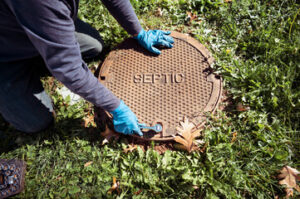Septic tanks are one of the most overlooked and under-appreciated parts of your home. Regularly getting your tank pumped helps prevent sewage odors, costly system repair and long-term damage to your drain field.

Septic tanks need to be pumped when the sludge and scum levels reach their tops. This means that solid particles are escaping your septic system into the soil absorption area and clogging up drains and toilets. Contact Septic Tank Pump Out Perth for professional help.
The cost of having your septic tank pumped depends on the size and location of your tank, as well as how much waste your household produces. A small tank with a capacity of less than 750 gallons typically costs $300 or less to pump, while a larger tank can cost up to $600. Tank location also influences the cost, with septic tanks in rural areas often costing more to pump than those in urban areas.
Septic systems need to be inspected and cleaned on a regular basis to ensure proper operation. These services can be costly, but it’s essential to protect your home from sewage leaks and contamination. You can reduce the frequency of septic tank cleanings by limiting the amount of solid waste added to the system and by installing water-efficient appliances. It’s also important to avoid planting trees and shrubs with aggressive roots near the septic tank, as these may infiltrate pipes and cause problems.
Sludge and scum build up in the septic tank, with a layer of solid waste sinking to the bottom and a layer of fats and oils floating on top. The clear wastewater in the middle, known as effluent, flows out to your leach field. If the sludge layer reaches within 6 inches of the outlet pipe or the scum layer reaches 12 inches, you’ll need to have your septic tank pumped out.
How often you need your septic tank pumped also depends on your tank size, the number of people in your household, and the type of waste you produce. A smaller tank holds less waste, so it can go longer between pumpings than a large tank. Larger households generate more waste and fill the septic tank faster, so they need to have it pumped more frequently.
Septic tank cleanings are usually done by a professional who uses a specialized truck to vacuum the contents of your tank. The process begins by locating and uncovering the tank. Then, the technician inserts a hose into the tank and pumps in the sludge and liquid. He or she will also remove any solids that cling to surfaces. Finally, the technician will inspect the septic system to identify any potential problems and clean or repair filters.
Time
Septic tanks hold and store a variety of solid waste, including feces, toilet paper, cellulosic compounds from plants, and food. While some of this waste is instantly biodegradable, the bulk of it is not and can clog and fill the tank. In order to prevent a full septic tank, you should get it pumped regularly. However, the frequency of septic tank pumping depends on several factors. The size of the septic tank, how many people live in your home, and your water usage are all important considerations.
Ideally, septic tank waste goes down into the leach field where it gets absorbed and broken down into a liquid form. However, if you have a full tank and a poorly functioning septic system, the untreated sewage can enter water sources like rivers, lakes, and streams, which can then become contaminated with pathogens that can cause health issues in humans. In addition to contaminating water, the excess septic waste can also create an unpleasant odor and pose a risk of contamination to the surrounding landscape and wildlife.
The best way to determine when your septic tank needs to be pumped is to monitor the level of sludge within your tank. To do this, carefully lift the septic tank lid and use a long stick to reach to the bottom of the tank. Lower the stick until you feel it touch the dark sludge at the bottom of the tank. Then, using the velcro end of the stick, measure the depth of the sludge to determine how much is in the tank.
In addition to monitoring the septic tank levels, you can take other steps to help keep your septic tank healthy and working well. For example, try to reduce your water usage so that less waste enters the septic system. This includes taking shorter showers and using your washing machine and dishwasher sparingly. It is also a good idea to limit how often you put food into your garbage disposal, since organic food waste can clog the septic tank and leach field.
If you can reduce the amount of solid waste that enters your septic tank, it will not only save you money on septic tank pumping, but it will also protect your water source and keep your home healthy. However, if you are not careful and your septic tank becomes overfull, it will be expensive and time-consuming to have it pumped and cleaned.
Safety
Septic tanks contain toxic wastes that can pose health risks to anyone who enters or approaches them. This is because septic tanks produce gases like methane and hydrogen sulfide during the decomposition process, and they can also be corroded or collapse over time.
When a homeowner decides to get their septic tank pumped, they must take several safety measures into account. First of all, they should be sure to hire a reputable service provider that is licensed and insured. In addition, they should prepare the area around their septic tank to ensure that there are no obstructions. This means putting away toys, moving furniture, and removing anything else that could interfere with the septic tank pumping process.
During the septic tank pumping process, homeowners should be careful not to disturb the solid waste layer that floats on top of the liquid waste. This layer is important because it protects the drain field from contamination. If the solid waste layer is disturbed, it can contaminate the septic tank and eventually the groundwater supply. Moreover, the solid waste can also cause blockages in the drain pipes.
In addition, homeowners should avoid putting toxic chemicals in their septic system. These chemicals can poison the wastewater that reenters local waterways and can cause disease in people and animals. Some examples of toxic chemicals that can be found in septic systems include paint, insecticides, and weed killer.
Keeping up with routine septic tank pumping is one of the best ways to prevent these hazards. However, some homeowners may not be able to afford it or may feel that their septic system is working fine. It is important for homeowners to know the signs that they should look out for so they can have their septic tank pumped sooner.
The most obvious sign that a septic tank needs to be pumped is if the drains become slow or clogged. Another sign is if there is standing water in the yard or if there are wet spots in the garden. Other symptoms include odors and if the toilets and kitchen sinks are slow to flush.
Equipment
Septic tank pumping companies use a large truck equipped with a vacuum hose to remove sludge from the tank. They also clean the tank interior using water to flush away any remaining solids, then they return the septic tank to its original condition. When selecting a septic tank pumping company, ask for recommendations from friends and family members. Then, do some research to find a company that offers experience, reliability and competitive prices.
Septic tanks retain and separate sewage waste while letting the clear wastewater, known as effluent, flow out into the absorption field where it is biologically treated before reaching groundwater. It is important to pump the septic tank regularly to ensure that the system works properly.
The frequency of septic tank pumping depends on several factors, including the size of the household and how much waste is generated per day. Smaller households generate less sewage and therefore need to pump their septic tank less frequently. However, larger households tend to fill up their septic tank more quickly.
Regular septic tank pumping is essential for keeping the septic system functioning properly and protecting the surrounding environment. Sewage overflows into the surrounding soil can cause health and environmental problems. It is recommended that homeowners keep a record of septic tank levels to determine how often the septic tank should be pumped.
When it comes to septic tank pumping, the most important factor is to choose a reliable, trustworthy and licensed service provider. It is best to avoid the cheapest options, as they may not have the equipment and expertise needed to complete the job correctly.
Homeowners should look for signs that the septic tank is full, such as slow drains in sinks and toilets. Getting the septic tank pumped promptly can prevent clogged pipes and drains, which can be costly to fix. Moreover, it can save you from the unpleasant and unsanitary smells of a full septic tank.


